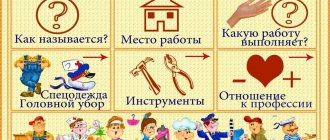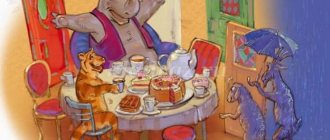GCD in the senior group “Country of Professions”
"Country of Professions"
Goal: to consolidate children’s knowledge about creative professions
.
Tasks:
Educational:
Expand and clarify children’s ideas about the work of people in creative professions
.
Educational:
Consolidation and generalization of material related to the concept of “music”; consolidation of ideas about the emotional impact of a musical work.
Educational:
Cultivate interest in creative professions
.
Methodological techniques: game questions for children, productive activities of children
Equipment: projector, slides with professions
.
Conducting GCD:
Guys, today we received a letter to our kindergarten email, let's open it and see who it is from and what is written in it.
Letter: “Dear guys, hello! Dunno writes to you from Flower City! I quarreled with my friends: Znayka, Guslya and Tube. Znayka always offers to read books, Guslya invites to listen to music, and Tube shows his paintings. Why do we need books, music, paintings? You need mittens to keep your hands warm, pancakes to eat them, an umbrella to keep from getting wet in the rain. But why people invent books, music and paintings - I don’t understand! And my friends were offended by me and stopped talking! Help me make peace with them!”
The teacher offers to help Dunno and go to the land of professions, where people live who invent music, stories and paint pictures.
The teacher reads the magic words, and an image of a country of professions appears on the screen.
I’ll take a wand in my hands, I’ll call on magic. A wonderful miracle, appear, show yourself to our children. I will open the magic door, I will invite a miracle to visit. Magic calls us, takes us to the land of professions.
The teacher asks what professions the children know. Do the guys know what creative professions are? What creative professions do they know?
These are painters and sculptors, poets and writers, composers and musicians, actors, singers and dancers. The teacher asks a riddle:
We are all friends with books, Each of us is a reader. And, of course, they should know what writes them... (writer)
(A picture of the composer appears.)
The teacher asks the children what their favorite books are. What does a writer use to write books? What kinds of stories are there? (sad, funny, magical, about nature, etc.)
The teacher asks if everyone can be a writer. Is it easy to write interesting stories? Why are writers needed?
The teacher asks the following riddle:
I have a pencil, Multi-colored gouache, Watercolor, palette, brush And a thick sheet of paper, And also a tripod easel, Because I... (artist)
(Artist's image appears)
The teacher asks the children what the artist does. What do artists use to create their works? What does an artist need to work?
The teacher shows the pictures. He asks what is shown in the paintings? What mood do they evoke? Can anyone draw such pictures?
The game “What tools does an artist need for work” is being played?
The teacher asks the following riddle:
He writes music for us, He plays melodies, He puts poems to the waltz. Who writes the songs? (composer)
(The image of the composer appears.)
The teacher asks if the children like music. Where do children hear music? Who comes up with the music?
The teacher says that there are different composers: some write songs, others write classical music, which is performed by an orchestra (in the theater, opera, ballet).
The teacher asks what the composer uses to record music. (using notes)
The teacher demonstrates the notes. The teacher asks if each person can come up with a melody and play it from the notes. What does it take to be a composer?
The teacher says that the composer, with the help of sounds, conveys various emotions, moods, and tells a story without words.
The teacher offers to listen to two musical works by composer A. Vivaldi from the cycle “The Seasons”: “Winter” and “Summer”. Which piece of music is dedicated to winter and which to summer? Offers to correlate musical works with illustrations.
Next, the teacher offers to record a video message to Dunno and explain why people write stories, poems, music, and paintings.
At the end of the lesson, the teacher invites the children to turn into artists. The teacher asks what time of year it is now. What happens in the fall? What mood does autumn evoke? What mood does today's activity evoke?
The teacher suggests drawing an autumn landscape that would convey the child’s mood at the moment (sad autumn, happy autumn).
An exhibition is being organized. Children can optionally talk about what kind of autumn they drew.
Summary of GCD in the senior group on the topic “Professions”
GCD in the senior group of a preschool educational institution on the topic: “All professions are important, all professions are needed”
Goal: Expand children’s understanding of the diversity of professions Objectives: Form a generalized concept of “profession”, enrich active vocabulary Develop attention, memory, thinking Cultivate positive motivation for learning, respect to the work of adults. Visual material: V.V. Mayakovsky’s book “Who to be?”, cards with pictures, “magic chest”, clothes for a cook, sailor, salesman, policeman; tools for every profession: for an artist - a brush, for a cook - a ladle, for a driver - a car, for a musician - a violin. Preliminary work : 1.Reading a poem by V.V.
Mayakovsky "Who to be?" 2. Examination of illustrations with different professions of people 3. Physical education .4. Educational board game “Professions” 5. Excursion to the library. Progress of the lesson.
1. Creating motivation for the lesson. Educator: -Children, which of you wants to grow up quickly and become an adult? -Tell me, where do your moms and dads, adults, go every day? Children: adults, mothers and fathers go to work - Why do people go to work? Children: to earn money, build houses, drive cars, grow bread. -What do your parents do? (Ask each child) -What benefits do they bring? Children: they sew clothes, teach children, treat the sick, prepare food, transport goods. Educator: - That's right. Now listen to the poem by V.V. Mayakovsky "Who to be?" The teacher reads a poem. -What is the poem talking about? Children: the poem talks about professions. Educator: What does the word “profession” mean? Profession means: business, work, occupation. People work what they like to work with, do what they do best. There are many professions in the world. Name the professions that you know? Children: teacher, driver, worker, salesman, doctor. 2. Statement of the problem situation. - Guys, it’s hard to imagine what we will do without doctors when we get sick. -What would we wear if there were no tailors?! -What would they eat if it weren’t for the work of people who grow bread, vegetables, and fruits? -How empty and uncomfortable our room would be if it weren’t for the joiners and carpenters. 3. Discovery of something new . 1. Game “What is he doing?” Goal: Continue to acquaint children with the actions of people of different professions. I name the profession, and you answer what a person in this profession does. Doctor - treats Teacher - teaches Salesman - sells Cook - cooks Educator - educates Driver - drives a car Builder - builds All professions are needed, all professions are important. The main thing is that you need to do your favorite job well. 2. Game “Who needs what for work?” Goal: To consolidate children’s understanding of the subjects of each profession. -People of different professions use different tools for their work. I have a “wonderful chest” that contains many interesting things. To find out what lies there, you need to say the following words: “Chest, chest, open your barrel a little.” Ruslan, look into the chest, but first say the magic words. -Who needs this item? Children: this tool is needed for an artist. Educator: Well done, guys, you named all the subjects and professions. correct 3. Psycho-gymnastic exercise. Goal: To learn to depict the emotional state of people of different professions, using expressive movements and plasticity. -Each of you must choose any profession and portray it not only through action, but also through facial expressions. How do you show a driver, an artist, a musician, a hairdresser? 4. Game “Correct the mistake” (1 min) - Let's look carefully at these pictures and find the mistakes that Dunno made while drawing these pictures. (The cook is doing his hair, the musician is painting the walls) 5. Proverbs about work. (2min) -Explain how you understand proverbs. 1. You can’t even pull a fish out of the pond without difficulty. Children: you definitely need to work hard for something to work out. 2. Labor feeds a person, but laziness spoils him. Children: if you don’t work, you will become a bad person, lazy. Educator: The main thing in a person’s life is work. Reflection: What professions did you guys like? Who would you like to work with? Why?
We recommend watching:
Summary of GCD in the middle group on the topic: Profession of a pastry chef Summary of the lesson in the middle group. Profession postman Entertainment for children of the preparatory group on the topic: Professions Targeted excursion to the kindergarten kitchen “What is the cook cooking for us for lunch?”
Similar articles:
Summary of lessons in kindergarten in the 2nd junior group. Doctor's profession
Lesson in the middle group of kindergarten. Professions of rural people
Children about the medical profession
Children about the lifeguard profession
About the profession of a museum worker for children



